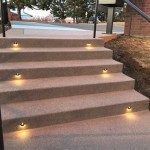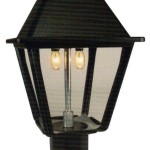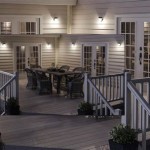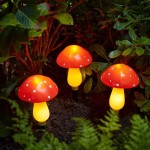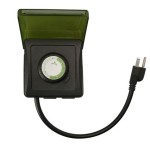Illuminating Your Outdoor Culinary Space: A Comprehensive Guide to Outdoor Kitchen Lighting Ideas
Outdoor kitchens have become increasingly popular, extending living spaces beyond the confines of the home. These al fresco culinary havens require careful planning, and proper lighting is paramount. Illumination not only enhances the functionality of the space, allowing for safe and efficient cooking after sunset, but also contributes significantly to the ambiance and overall aesthetic appeal. A well-lit outdoor kitchen invites gatherings, creates a welcoming atmosphere, and transforms an ordinary backyard into an entertainment hub.
This comprehensive guide explores various outdoor kitchen lighting ideas, offering insights into different lighting types, placement strategies, and design considerations to help create a functional and visually appealing outdoor cooking and dining area. The focus will be on practical applications and design principles that ensure both safety and aesthetic harmony.
Understanding the Importance of Layered Lighting
Effective outdoor kitchen lighting doesn't rely on a single light source. Instead, it employs a layered approach, combining different types of lighting to achieve optimal illumination and create a desired atmosphere. Layered lighting typically consists of three main categories: ambient lighting, task lighting, and accent lighting. Understanding the roles of each category is crucial for planning an effective lighting scheme.
Ambient lighting, also known as general lighting, provides overall illumination to the space. It sets the mood and ensures that the entire outdoor kitchen area is adequately lit for basic navigation and socialization. Task lighting, on the other hand, focuses on specific areas where activities like food preparation, grilling, and serving take place. This type of lighting is brighter and more direct, providing the necessary visibility for these tasks. Accent lighting highlights specific features of the outdoor kitchen, such as architectural details, landscaping, or decorative elements. It adds depth and visual interest, enhancing the aesthetic appeal of the space. By carefully incorporating all three types of lighting, it is possible to create an outdoor kitchen that is both functional and visually stunning.
Consider the size and layout of the outdoor kitchen when planning the lighting scheme. Larger kitchens may require more ambient lighting to adequately illuminate the entire space. Also, the placement of cooking surfaces, countertops, and other work areas will dictate the need for specific task lighting solutions. Finally, identify architectural elements or landscaping features that could benefit from accent lighting to enhance the overall design.
Exploring Different Types of Outdoor Kitchen Lighting
Numerous types of lighting fixtures are suitable for outdoor kitchens, each offering unique features and benefits. Selecting the right fixtures depends on the specific lighting needs, the overall design aesthetic, and budget considerations. The following are some of the most common types of outdoor kitchen lighting:
String Lights:
String lights are a popular and versatile option for creating a festive and inviting atmosphere. They can be hung between trees, draped across pergolas, or strung along fences. String lights come in various styles, including traditional incandescent bulbs, energy-efficient LED bulbs, and decorative globe lights. Consider using dimmable string lights to adjust the brightness according to the mood and occasion.Recessed Lighting:
Recessed lights are installed flush with the ceiling or underside of a structure, such as a pergola or gazebo. They provide a clean and streamlined look and are ideal for providing ambient or task lighting. Recessed lights can be used to illuminate countertops, grilling areas, and dining tables. Ensure that the recessed lights are rated for outdoor use and are properly sealed to protect against moisture.Pendant Lights:
Pendant lights hang from the ceiling and can add a touch of elegance and sophistication to an outdoor kitchen. They work well over islands, bars, or dining tables. Choose pendant lights that are specifically designed for outdoor use and are made from weather-resistant materials. Consider the height of the pendant lights to ensure that they provide adequate illumination without obstructing views or movement.Spotlights and Floodlights:
Spotlights and floodlights are used to highlight specific features of the outdoor kitchen or landscaping. Spotlights provide a focused beam of light, while floodlights offer a broader area of illumination. These lights can be used to accent architectural details, illuminate pathways, or highlight plants and trees. Use these lights sparingly to avoid creating excessive glare or light pollution.Undercabinet Lighting:
Undercabinet lighting is installed underneath cabinets and countertops to provide task lighting for food preparation and other activities. LED strip lights are a popular choice for undercabinet lighting because they are energy-efficient, long-lasting, and easy to install. Choose undercabinet lights that are dimmable to adjust the brightness as needed.Path Lighting:
Path lighting is used to illuminate walkways and pathways around the outdoor kitchen, ensuring safe navigation after dark. Path lights come in various styles, including bollard lights, stake lights, and landscape lights. Choose path lights that are durable and weather-resistant and that provide adequate illumination without being overly bright.Post Lights:
Post lights are mounted on posts or pillars and can be used to illuminate the perimeter of the outdoor kitchen. They provide both ambient lighting and security lighting. Choose post lights that are compatible with the architectural style of the outdoor kitchen and that provide adequate illumination without creating excessive glare.Strategic Placement for Optimal Functionality and Aesthetics
The placement of outdoor kitchen lighting is just as important as the type of lighting used. Strategic placement can enhance the functionality of the space, improve safety, and create a visually appealing atmosphere. Several factors must be considered when determining the optimal placement of outdoor kitchen lights.
Task Lighting Placement:
Task lighting should be placed directly above or in front of the areas where tasks are performed. For example, undercabinet lighting should be installed underneath cabinets above countertops to provide adequate illumination for food preparation. Similarly, recessed lights or pendant lights should be positioned above the grill or cooktop to provide visibility while cooking.Ambient Lighting Placement:
Ambient lighting should be distributed evenly throughout the outdoor kitchen to provide overall illumination. This can be achieved by using a combination of recessed lights, string lights, and post lights. Consider the layout of the outdoor kitchen and the placement of furniture when determining the optimal placement of ambient lighting.Accent Lighting Placement:
Accent lighting should be placed to highlight specific features of the outdoor kitchen, such as architectural details, landscaping, or decorative elements. Spotlights and floodlights can be used to accent these features, but use them sparingly to avoid creating excessive glare or light pollution. Consider the angle and intensity of the light when positioning accent lights to achieve the desired effect.Safety Considerations:
Safety should be a primary concern when planning outdoor kitchen lighting. Ensure that all electrical connections are properly grounded and protected from moisture. Use weatherproof fixtures and wiring that are specifically designed for outdoor use. Avoid placing lights in areas where they could create a tripping hazard or interfere with movement.Controlling Glare and Light Pollution:
Excessive glare and light pollution can detract from the enjoyment of the outdoor kitchen. To minimize glare, use shielded fixtures that direct light downwards. Avoid using overly bright lights, and consider using dimmers to adjust the brightness as needed. To reduce light pollution, direct light only where it is needed and avoid illuminating unnecessary areas.Integrating Lighting with Landscaping:
Outdoor kitchen lighting can be integrated with landscaping to create a cohesive and visually appealing design. For example, path lights can be used to illuminate walkways and pathways, while spotlights can be used to highlight trees and shrubs. Consider the color and texture of the plants when choosing lighting fixtures and placement to create a harmonious and natural look.Pay attention to the color temperature of the bulbs used in the outdoor kitchen lighting. Warmer color temperatures (around 2700-3000K) create a cozy and inviting atmosphere, while cooler color temperatures (around 4000-5000K) provide brighter, more task-oriented illumination. Mixing color temperatures can create visual interest and highlight different areas of the outdoor kitchen.
Additionally, consider incorporating smart lighting technology into the outdoor kitchen lighting scheme. Smart lighting systems allow you to control the lights remotely using a smartphone or tablet. You can adjust the brightness, change the color temperature, and even set schedules for the lights to turn on and off automatically. This can enhance convenience and energy efficiency.
By carefully considering the types of lighting, placement strategies, and design considerations discussed above, it is possible to create an outdoor kitchen lighting scheme that is both functional and aesthetically pleasing. A well-lit outdoor kitchen will enhance your enjoyment of the space and create a welcoming atmosphere for friends and family.

10 Outdoor Kitchen Lighting Ideas 2024 Brighten The Spot Design Countertops

Outdoor Kitchen Lighting Ideas For Your Home Shafer Electric

Tips For Outdoor Kitchen Lighting Peterson S Landscape Maintenance

Outdoor Kitchen Grill Lighting Ideas

Outdoor Lighting

Outdoor Kitchen Lighting Ideas Tips For Northern Virginia Homeowners

8 Outdoor Kitchen Lighting Ideas

5 Outdoor Kitchen Lighting Ideas Cricket Pavers

Outdoor Kitchen Lighting Trends

Outdoor Kitchen Grill Lighting Ideas
Related Posts
